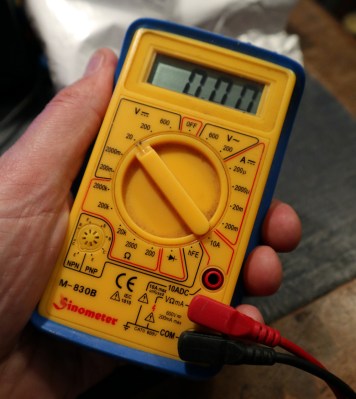If we had to make a guess at the single piece of electronic bench equipment owned by the highest proportion of Hackaday readers, it would not be a budget oscilloscope from Rigol, nor would it be a popular portable soldering iron like the TS100. Instead we’re guessing that it’s a multimeter, and not even the most accomplished one.
The DT830 is a genericised Chinese-manufactured 3.5 digit digital multimeter that can be had for an astonishingly low price. Less than a decent hamburger gets you an instantly recognisable plastic case with a chunky rotary range selector switch, and maybe a socket for some kind of transistor or component tester. Make sure that there is a 9 volt battery installed, plug in the pair of test leads, and you’re in business for almost any day-to-day electrical or electronic measurement. They’ve been available in one form or another for decades and have been the subject of innumerable give-aways and loss-leader offers, so it’s a reasonsble guess that you’ll have one somewhere. I have three as far as I know, they make great on-the-go instruments and have proved themselves surprisingly reliable for what they are.
Persuading You Is Going To Be A Tough Sell

If you talk about the DT830 in polite company, you might be greeted with snorts of derision. It’s not difficult to find reviews that tear one down and compare it to a more expensive meter, and not surprisingly find the pricey meter to be of higher quality.
And it’s certainly true that for a couple of dollars, you get a switch that won’t last forever and high voltage isolation that maybe isn’t quite up to spec. But I’m going to advance a different take on the DT830 that may surprise some of you: to me it’s a modern classic, an instrument that provides performance for its price that is nothing short of phenomenal. Because that pocket-money meter not only measures voltage, current, and resistance, it does so accurately and repeatably, and to compare that with what might have gone before is to show just much better a device it is.
Thirty years ago, a digital multimeter was an expensive item, and most multimeters were still analogue. A cheap multimeter was therefore invariably a small pocket analogue device, and the very cheap ones could be astoundingly awful. Accuracy and repeatability in reading wasn’t their strong point, and while I am a great fan of analogue multimeters when it comes to spotting dips and trends in tweaking analogue circuitry, even I can’t find reason to praise the inexpensive ones. By comparison the DT830 delivers reliable and accurate readings with a high-impedance input, something I would have given a lot for in 1985.
That Performance Is No Fluke

So given that it costs considerably less than a pint of beer in a British pub, how does such a cheap instrument do it? The answer is, by standing on the shoulders of giants. My colleague Anool Mahidharia supplied the answer here back in 2017 when he took a look at the Intersil 71XX series of integrated circuits; the archetypal DT830 contains an ICM 7106 3.5 digit digital panel meter chip, whose roots lie in a much more exclusive stratum of the industry.
(Despite there being a load of newer and more accomplished multimeter chips on the market I was surprised to find that none of them had found their way into the meters I’d opened.)
The ICM 7106 was based on work Intersil did in 1977 to produce the part in Fluke’s first portable DMM, the model 8020A.

So you’re not getting anywhere near the physical design or component quality of that expensive meter, but you are benefiting from the tech that made its ancestor a very good instrument for the 1970s. The dual-slope integrating ADC and precision reference are the same as the ones in many far more expensive meters, which is what makes the reading from your few-dollar DT830 one you can trust. Not bad for something you might dismiss as a piece of junk!
If there is something to be gleaned from this story, it is a very real demonstration of the power of semiconductor manufacturing. Assuming it has passed acceptable factory QA, every 7106 is as good as any other 7016, from the first one made by Intersil in the 1970s through to the unknown-origin chip hiding under an epoxy blob in my cheap meter. The manufacturer can skimp on every other component in the meter, but assuming that there’s no money in counterfeiting a 43-year-old chip that long ago left its premium product phase behind and has been manufactured by many sources over the years, they can’t skimp on the chip that powers it. To be an ICM7106, it must have the same features as the original from the 1970s, thus my bargain-basement meter still shares something that matters with one of far higher quality.
The DT830 multimeter, then. It may be a heap of junk, but it’s an astonishingly good heap of junk. I for one, salute it.

















I remember a yellow one I modified to be a ESR meter http://eletronicajacimar.blogspot.com/2010/12/medidor-de-esr.html
I opened it and put in a office scanner, then I used the image to outline the PCB using the great Target3001 software, this way the PCB would fit like a charm into the case ,then added a led and voila! I was repairing all kind of stuff by simply finding those bad capacitors and leaky coils. Sadly the device rest in peace cos I leave it outside many days during vacations and the rain did the rest :(
Now I just got the idea of interfacing another one with a micro (I have some attiny85’s somewhere!) so we can add buttons instead of the mechanical selector so we can have the almost eternal cheap meter ever considering we can replace buttons, but we cannot easily replace the rotary thing.
I love these and they’re indeed great for most measuring needs.
Only thing I *really* miss on them is a continuity test beeper.
“THAT PERFORMANCE IS NO FLUKE” – that paragraph title deserves a Pulitzer Prize.
Well, I’m not such a fan of this multimeter. I’ve got one many years ago from ebay, and while it still works, the accuracy is bad (something like 5-10% error depending on the range selected) and there’s no fuse inside. I found it one day when I used it to measure a voltage with the wires plugged in the amp socket. The wires got surprisingly hot :D
1. Meters of the type described here are extremely good, and due to the fact that they’re based on the dual-slope method of A-to-D conversion, are highly accurate, as well as being self-calibrating / auto-zeroing (the down-side to dual-slope conversion is speed: most examples of this type conversion have a 2-5 conversion / second rate (max); but that’s just fine for this application, or for any ‘human-readable’ application). All my versions of this DMM have always been “dead-on” accurate. The biggest drawback to this type meter comes from acceptance–with attendant ‘bad-mouthing’–by the snobs, who feel that it can’t be any good, because of the price.
If you ensure that the device you buy has a reasonable ‘build quality’, one of these devices will provide years and years of reliable, accurate service.
2. The suggestion(s) to ‘hack’ meters of this type is an extremely good one, and probably should be pursued (and would, I think, make for a very good article, Ms. List), given the extreme popularity and ubiquitous nature of these devices.
Reasonable and very strict limits ought to be imposed, to deter those effetes who will always want to ‘hack’ by involving and employing the use of some sort of microprocessor. No! Just, plain, NO!!
3. There have been some comments about the ‘AC’ function’s not ‘functioning’ properly. It should be known that this is a direct carry-over from the days of analog multimeters, when measuring the AC line was considered the only common need, and the ‘AC’ function of the multimeter was accomplished by routing the input through a half-wave rectifier and then displaying the output on another scale, on the meter face, which was then calibrated, or printed to display the AC in ‘RMS’ units (that’s why you’ll find some meters which proudly tout the fact that they’re “True-RMS” meters, and are priced accordingly). Sometimes it helps to know the ‘why’ behind the ‘what’. None of the devices here, to my knowledge, purport to do a ‘true-RMS’ conversion. They should, however, come with a caveat that the ‘AC’ function is for measuring AC power lines only / mostly.
4. VERY good article.
But while the basic reading may be accurate, what about the voltage divider string to get the other ranges? I would think that can bring in inaccuracy, cheap resistors is one way to lower the cost.
I was hoping for this article for some time because it deserves it. Thanks!
I really like this meter. If you understand its limitations and price it turns into useful tool. It costs less than pair of test leads you should buy because original ones die fast.
Display on this meter is always readable – something that is not so common in other meters. Even some fluke meters could learn.
I like that blue holster on the photo. I found only yellow – will couple it with grey meter to make it look like flukewannabe.
Once I have seen a guy with dt830 tatoo which brings question: is there any Joe Kim graphic with dt830?
You read my mind! I was thinking about the story behind this meter. It really deserve it! Otherwise who would tattoo it on his arm?
https://i.pinimg.com/originals/30/bc/36/30bc365ac583cb9d85b737b9641fe745.jpg
Where can I get this nice blue holster?
Also was sure there was Joe Kim art related to this meter was there?
Finding the calibration pot on mine certainly added some value.
I suspect the IC is something other than ICL7106, maybe AME7106? because these meters have low battery indicator but ICL7106 doesn’t have low battery pin output, while AME7106 has it.
Hello, guys! I since long ago had a lot of these DT-830s, they are quite good despite low quality leads and nobs, and also being too easy to “burn”. However, I noticed that in the last few years the quality dramatically decreased, as long time ago I was able lo measure switched mode power supplies with them, now its impossible due to erratic response, should be probably a key filtering capacitor removed from somewhere at the input of the IC, do somebody knows where specifically to look (and put one) for it? the chip is under a black drop, so only traces with resistors are visible. Analog multimeters had a couple of diodes in anti-paralel for protection against high-voltage on the moving coil, these digital had something alike? I suppose this will be probably a good spot for a filter
The original DT830 was an exceptional product, Uni-T named it SJ30B, it looks on the inside like your photo. For THT components they crammed everything in a tiny case, the rotary switch was smooth with springs and balls in dents, the circuit to use the resistor ladder for voltage and current and resistance measurement was ingenious, only the AC section with a single diode that could not measure below 200V was disappointing, but a better one would not fit into the encasement.
But beware of the newer slighty smaller ones that have a 45 degree slope in the rotary knob: while there are different companys that make them, all are of poor quality (the knob does not rotate smoothly, the transistor socket does not contact good), electrically unsave up to the point european RAPEX withdrew them from market, many are not precise because they do not use the ICL7106/7126 anymore. Still called 830, they are crap. And the 832 with audible continuity test was always the better choice.